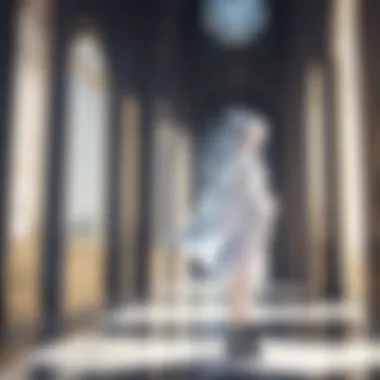Exploring the Intricacies of Glass Reflection


Intro
The interaction of light with glass surfaces is a fascinating area of study that impacts multiple fields, from architecture to optics. When light strikes glass, it does not merely bounce off; it undergoes a complex series of reflections and refractions. Understanding how glass reflection operates is essential both for aesthetic applications in design and for technical applications in science.
In this article, we will break down the fundamental principles of glass reflection. We will explore its effects on architectural aesthetics, delve into its significance in art and design, and investigate its applications in technology. By grasping these dynamics, readers will gain insight into the broader implications of glass as a material in both everyday life and specialized contexts.
The Science Behind Glass Reflection
Before discussing practical implications, it is crucial to understand the underlying physics. Glass possesses unique optical properties that facilitate distinct interactions with light. These properties include its refractive index and surface smoothness, which play key roles in how glass reflects light.
Key Concepts
- Refraction: This is the bending of light as it passes through different media. Glass, being denser than air, causes light to slow down and change direction.
- Reflection: When light hits the surface of glass, some of it reflects back while the rest continues through the glass.
- Transmission: This refers to the portion of light that successfully passes through the material.
Practical Implications
In architecture, glass is often used in large windows and facades. The way a building reflects surrounding light and shadows can significantly alter its appearance throughout the day. In design, glass plays a key role in creating visual depth and texture through various finishes and coatings.
Aesthetic Impacts in Architecture
The use of glass has transformed modern architecture. Buildings like the Glass House, designed by Philip Johnson, exemplify how glass can integrate nature and built environments. The reflective qualities of glass enhance aesthetic experiences by mirroring the surroundings.
Factors Influencing Aesthetic Appeal
- Location of the Building: Proximity to water bodies or greenery can enhance reflections.
- Time of Day: The quality of light changes with the sun’s position, affecting how reflection is perceived.
- Glass Treatments: Tinted or coated glass alters the light that is reflected, creating different visual effects.
Implications in Technology
Glass reflection is not only an artistic consideration, but also a scientific one. In optics, for example, understanding reflection is fundamental to designing lenses and mirrors. Specialized coatings on optical glass can enhance or reduce reflection as needed, impacting everything from cameras to telescopes.
Technological Applications
- Optical Fiber Communication: This technology relies heavily on the principle of total internal reflection, where light signals are transmitted through glass fibers, minimizing loss.
- Display Technology: In screens, controlling glass reflection is crucial for reducing glare and improving visibility.
The End
"By examining how light interacts with glass, we unlock a deeper understanding of not just architecture, but the fundamental principles of optics."
This comprehensive exploration of glass reflection opens doors to further study in both creative and technical sectors, highlighting its multifaceted importance. It serves as a testament to the integral role of science in art, appealing to both creatives and specialists alike.
Preface to Glass Reflection
Glass reflection is a topic that embodies the unity of art, science, and practical application. Understanding how glass interacts with light is essential in several domains, including architecture, art, and technology. The complexities of glass reflection extend beyond mere visual appeal; they encompass fundamental scientific principles, historical uses, and cultural significance.
The benefits of exploring glass reflection are significant. For architects, the reflection properties of glass can transform natural light into effective design elements, enhancing both aesthetics and functionality. In art, glass as a medium allows artists to manipulate light, creating depth and dimension in their work. Moreover, in technology, the principles of how light reflects off glass form the basis of advancements in optics and materials.


Considerations surrounding glass reflection include its impact on energy efficiency and human perception. Reflective glass can help manage heat and light in buildings, contributing to sustainability efforts. Furthermore, the psychological effects of reflection in art and architecture can influence how people interact with their environments.
In summary, this introduction sets the stage for a deeper investigation into the nature of glass reflection. The forthcoming sections will delve into scientific principles, applications in various fields, and the cultural implications of this fascinating phenomenon.
Scientific Principles of Reflection
Understanding the scientific principles of reflection is integral to grasping how glass interacts with light. This section will evaluate the basic elements that form the framework for such interactions. The importance of these principles lies not only in their academic value but also in their extensive applications across various industries such as architecture, art, and technology.
The Nature of Light
Light is an electromagnetic radiation that humans can perceive. It travels in waves and exhibits both particle-like and wave-like behaviors. The speed of light in a vacuum is about 299,792 kilometers per second, which is fundamental when analyzing reflection phenomena.
When light strikes a surface, it can be reflected, refracted, or absorbed. The characteristics of the surface dictate the amount of each behavior. Glass is a transparent material, allowing light to pass through it with minimal absorption. This leads to a unique interaction where some light is reflected while the rest enters the material, demonstrating the dual nature of light. By examining these interactions, we can understand how glass can appear both clear and reflective depending on various factors like angle and surface quality.
Behavior of Light on Glass Surfaces
When light hits a glass surface, its behavior can be described mainly by two principles: reflection and transmission. The degree of reflection is influenced by the angle of incidence, which determines how much light bounces back and how much enters the material.
For clear panes of glass, a significant portion of light enters, but a small fraction reflects off the surface. This reflection is guided by the law of reflection, which states that the angle of incidence equals the angle of reflection. This fundamental rule helps in calculating how light behaves when it encounters different surfaces.
The finish of the glass surface is also vital. A smooth surface provides a clearer reflection, while a textured surface will alter this interaction, scattering more light and reducing clarity in the reflection. The treatments applied to the glass, such as anti-reflective coatings, can further manipulate this behavior, enhancing functionality in certain applications.
Critical Angle and Total Internal Reflection
The concept of the critical angle is crucial in understanding glass reflection. The critical angle is defined as the angle of incidence above which total internal reflection occurs. When light travels from a denser medium, such as glass, to a less dense medium, like air, there is a point at which the light cannot exit the denser medium but instead reflects back entirely.
This phenomenon is leveraged in various applications, particularly in fiber optics. By understanding and utilizing the principles of total internal reflection, engineers can design fibers that transmit light over long distances with minimal loss.
In practical terms, knowing the critical angle allows architects and designers to manipulate light in spaces, creating effects that can guide natural illumination while maintaining energy efficiency.
"The reflection of light off glass is not merely a visual effect; it embodies principles critical for modern engineering and design."
Understanding these scientific principles establishes a solid foundation for further discussion on the multiple applications of glass reflection in architecture, art, and technology.
Applications of Glass Reflection in Architecture
The use of glass reflection in architecture has grown significantly over the past few decades. It is not only a design strategy but also a means of integrating functional aspects with aesthetic appeal. Glass surfaces can manipulate light and perception, creating mesmerizing effects in both interiors and exteriors. One important element is how reflective glass enhances the visual qualities of buildings, allowing them to blend with their surroundings. This can create an illusion of space, ultimately contributing to a more harmonious environment.
In contemporary architecture, several benefits have been realized through the application of reflective glass. The visual impact is perhaps the most immediate. Buildings can appear more dynamic, changing with the weather and the time of day. Large glass facades reflect nature, sky, and cityscape, creating a dialogue between the structure and its environment. This interaction emphasizes the relationship between natural and artificial elements. It also promotes transparency, encouraging an open atmosphere, often sought after in modern spaces.
However, the considerations surrounding reflective glass must not be overlooked. Factors such as climate, location, and orientation influence its performance. Effective deployment involves understanding sun angles, shadow effects, and potential glare for occupants and nearby structures.
Aesthetic Uses in Modern Structures
The aesthetic application of glass reflection can transform ordinary buildings into landmarks. Large reflective surfaces often serve to distort and play with perspectives. Architects use this to create visual interest and to guide the eye. For example, the famous Crystal Cathedral in California brilliantly utilizes reflective surfaces to engage viewers visually.
In modern residential design, glass reflects evolving trends toward open and airy spaces. Many homes incorporate large windows or walls of glass, maximising natural light. The aesthetic benefits are substantial, as spaces feel more expansive and inviting. The subtlety of glass reflections create layers within a structure, allowing light to dance through spaces, enhancing colors and textures of interior design.


"Glass is not just a medium; it is a bridge between the inside and outside world."
Energy Efficiency Through Reflective Glass
Energy efficiency is another crucial advantage of glass in architecture. Reflective glass can drastically reduce heat gain in buildings, which leads to considerable savings in cooling costs. Special coatings on glass can reflect solar energy while allowing desired light to enter. This innovative use of glass minimizes the reliance on artificial lighting and air conditioning, contributing positively to environmental sustainability.
Benefits in energy expenses provide an immediate return on investment. Many architectural firms urge clients to consider reflective glass not only for its beauty but also for its cost-effectiveness over time. With increasing awareness of climate change, architects and builders aim to create more sustainability-conscious designs. Incorporating reflective glass into architecture is a powerful way to achieve this goal while maintaining an aesthetically pleasing environment.
The Role of Glass Reflection in Art
In the realm of artistic expression, glass reflection plays a pivotal role. Artists have long understood how reflective surfaces can transform perception, creating layers of meaning and engagement in their works. Glass not only serves as a medium but also as a tool to manipulate light and shadow, which enhances the narrative or conceptual elements of art. The interplay between reflection and transparency invites viewers to consider their surroundings and their own reflections, both literal and metaphorical.
Reflection in art can embody various themes such as illusion, reality, and self-awareness. Many artists use glass to create boundaries between the viewer and the artwork. These boundaries provoke questions about what is real and what is perceived. The aesthetic appeal of reflective surfaces often draws viewers in, making the artwork more immersive. Therefore, understanding the role of glass reflection in art provides insight into the complex ways artists engage with light, space, and audience.
Reflection as a Theme in Visual Arts
In visual arts, reflection emerges as a powerful theme. Artists utilize glass to convey a sense of duality, merging reality with illusion. This theme can be traced through various movements, from surrealism to modern installations. For instance, works by artists like Anish Kapoor and Olafur Eliasson reflect the environment, drawing attention to space, light, and perception.
The use of reflective materials allows artists to engage with their viewers, sometimes literally by showing their reflections. This interaction embodies the idea that art is not a static entity but a dynamic relationship between the audience and the piece itself. The viewer's presence alters the artwork, creating a moment that feels unique to that interaction.
Interaction with Light in Sculptural Works
Sculptural works incorporating glass reflection often challenge the boundaries of three-dimensional space. Artists design pieces that play with light, creating visual experiences that change with the viewer's position. The reflective quality of glass can cast shadows or create dazzling light patterns that animate a space.
For example, sculptures incorporating mirrors or glass prisms reflect not just light but also the surrounding environment. This creates an illusion of depth and interactivity. Viewers find themselves enveloped in the art, as the reflections pull them into a shared experience. Such interaction prompts a deeper engagement, as one contemplates the physical and conceptual layers in play.
"Art is not just what we see; it is about how we perceive what surrounds us."
Glass Reflection in Technology
The study of glass reflection plays a critical role in various technological applications, significantly impacting optical devices and innovations in material science. Understanding how glass interacts with light not only enhances our daily experiences but also propels advancements in multiple fields. Optical properties influence the design and efficiency of instruments used in myriad sectors, including telecommunications, healthcare, and consumer electronics. Moreover, breakthroughs in materials can lead to the creation of novel glass types that further optimize reflection attributes.
Optical Devices and Instruments
Optical devices rely heavily on the principles of glass reflection to manipulate and direct light. Instruments such as microscopes, telescopes, and cameras depend on specific glass types that maximize light transmission while minimizing loss. High-quality glass is essential to achieve clarity and precision in imaging, which is crucial in both research and everyday applications.
The role of coatings on glass surfaces cannot be overstated. Anti-reflective coatings, for example, reduce unwanted reflections, resulting in clearer images. These coatings increase the efficiency of lenses and sensors, thereby enhancing performance in devices like digital cameras and ocular equipment.
"In many applications, the quality of glass reflection can determine the clarity and functionality of optical devices."
Innovations in Material Science
Recent advancements in material science have unlocked new possibilities for glass reflection technology. Researchers are developing smarter glass materials designed to adjust their reflective properties based on external stimuli such as temperature and light intensity. This progress can lead to applications in smart windows, which adapt to reduce energy consumption by altering how light enters a building.
Another fascinating area of innovation is in coated glasses, where thin layers create specific reflective characteristics. These advancements pave the way for enhanced energy efficiency and improved aesthetic value in design. For instance, reflective glass is becoming essential in green architecture, contributing to sustainability by reflecting heat and reducing the need for artificial cooling systems.
Overall, the intersection of glass reflection and technology showcases its vital role in modern advancements and societal progression. As the field continues to evolve, ongoing research promises exciting breakthroughs that will reshape our interaction with glass in our everyday lives.


Cultural Significance of Glass Reflection
Glass reflection holds a unique place in human culture, one that transcends mere physical properties. It carries historical weight and symbolic meanings that resonate deep within various cultural expressions. Within the realm of literature, mythology, and cinema, glass reflection serves as a metaphor, illuminating themes of identity, perception, and the nature of reality. Understanding these cultural implications enriches our appreciation for the role glass plays beyond its functional uses.
Symbolism in Literature and Mythology
In many literary works, glass, particularly in its reflective form, symbolizes clarity and truth. Characters often encounter glass surfaces to reveal hidden aspects of themselves or to confront truths they might be evading. For instance, in Lewis Carroll's "Through the Looking-Glass," the act of looking into the glass becomes a journey of self-discovery and transformation.
Moreover, various mythologies incorporate reflection as a significant theme. In the Greek myth of Narcissus, the protagonist's obsession with his own reflection leads to a profound commentary on vanity and self-obsession. This highlights how glass reflection can symbolize not only beauty and self-awareness but also the potential dangers of excessive self-focus.
Exploring these symbolic layers offers insight into human psychology and societal values across different cultures. Reflective surfaces become artistic devices, illustrating complex themes that encourage readers to ponder the nature of self and the world around them.
Cinematic Techniques Involving Reflection
In cinema, glass reflection provides directors with powerful tools to convey deeper narrative elements. Filmmakers often use mirrors and glass as visual metaphors, representing duality or presenting characters in contrasting lights. Reflection can serve both to highlight and obscure aspects of character development.
For example, Alfred Hitchcock used reflective surfaces in "Vertigo" to explore themes of identity and obsession. A well-placed reflective shot can create tension, drawing viewers into the psychological intricacies of the characters.
Moreover, the ability of glass to distort or enhance the image adds complexity to storytelling. This aspect can symbolize clarity versus confusion, a common element in narrative structure. Using reflection in cinematography encourages the audience to engage at a deeper level, examining what is seen versus what is hidden.
Future Trends in Glass Reflection Research
Research into the future of glass reflection is critical in understanding how innovations will shape various industries. As technology evolves, the demand for advanced glass products increases. These advancements not only impact architectural design and aesthetics but also improve energy efficiency and environmental sustainability. Focused studies on glass reflection hold the potential to redefine how we perceive and interact with glass in our daily lives and specialized fields.
Emerging Technologies in Glass Manufacturing
The landscape of glass manufacturing is changing with the introduction of new materials and processes. Technologies such as float glass production, thin-film coatings, and smart glass are at the forefront of these changes.
- Float Glass Production: Traditional methods dominate, but innovations are making production more efficient. The introduction of high-speed production lines reduces costs and environmental impacts.
- Thin-Film Coatings: These are applied to glass surfaces to enhance reflection and reduce glare. Manufacturers are now creating coatings that can switch properties based on lighting conditions, thus optimizing visibility and energy efficiency.
- Smart Glass: Incorporating electronic modifications, smart glass can change its opacity in response to environmental stimuli, significantly impacting architecture and automotive design.
Each of these technologies showcases the importance of ongoing research in glass manufacturing. As more companies invest in this area, better products are likely to emerge, merging functionality with aesthetic appeal.
Potential Innovations in Reflective Surfaces
The future of reflective surfaces is promising, with potential innovations that could alter how we think about glass applications. Some key areas of focus include:
- Self-Cleaning Glass: This would have surfaces treated to repel dirt and grime. Innovations in nanotechnology are making progress in this area, raising the possibility of significantly lower maintenance costs in larger structures.
- Energy-Efficient Reflective Glass: Researchers are experimenting with materials that reflect more solar energy, thus lowering heating and cooling costs in buildings.
- Interactive Glass Surfaces: These surfaces will allow for dynamic interaction. For example, smart glass can be integrated with technology to display information or change transparency based on user input.
The continuous evolution of reflective glass surfaces shows that the potential for innovation is vast and can lead to enhanced functionality in various fields.
In summary, the exploration of future trends in glass reflection research is vital. It promises significant advances in both manufacturing technologies and innovative applications. Awareness of these trends remains crucial for architects, artists, and technologists alike as they navigate the intersection of functionality and design.
Epilogue: The Enduring Impact of Glass Reflection
In summarizing the intricate relationships between glass reflection and human experience, it becomes clear that the significance of this phenomenon extends far beyond mere aesthetics. Glass reflection has played a vital role in shaping the environments we inhabit and influencing our perception of spaces. Its scientific intricacies, coupled with its aesthetic applications, emphasize its enduring presence in various facets of life.
Reflecting on the Role of Glass in Society
The role of glass in society is multifaceted, reflecting not only light but also cultural values and technological advancements. From historical architecture adorned with stained glass to modern skyscrapers showcasing extensive glass facades, the use of glass mirrors our evolving relationship with the built environment.
- Cultural Expression: Glass reflection has been a canvas for artistic endeavors. Artists have exploited reflection to manipulate light, creating works that challenge perceptions and evoke emotional responses. This use of glass is seen in various art forms, especially where light interaction creates dynamic visual experiences.
- Architectural Influence: The adoption of glass in architecture has transformed city landscapes. Large reflective surfaces can create feelings of openness and connection to the surrounding environment. For instance, buildings like the Glass Pavilion in Toledo redefine space through the extensive use of transparent materials.
- Technological Integration: Advances in glass technology have allowed for enhanced energy efficiency and sustainability in structures. The reflective qualities of modern glass can reduce energy consumption in buildings, contributing to environmental goals.
- Psychological Impact: Glass reflection can also influence user experience in personal and public spaces. The interplay of light and reflection impacts mood, productivity, and comfort. Well-designed environments can promote well-being through careful consideration of glass elements.
"Glass is more than a medium; it is a reflection of our collective aspirations and technological progress."







